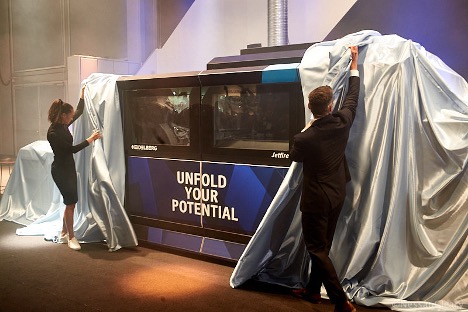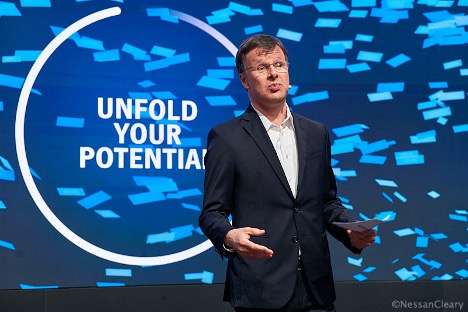Heidelberg and Canon have partnered on commercial inkjet in an arrangement that will see Heidelberg rebadging two Canon sheetfed inkjet presses configured with Heidelberg’s Prinect Workflow.
Peter Wolff, senior vice president Production Printing for Canon explained: “The two organisations share many business values but most importantly both companies have a very sharp focus on a long term partnership.” He added: “We all believe this is a great fit and a great moment for the printing industry that Heidelberg and Canon have agreed to cooperate together.”
Dr David Schmedding, Global Head of Sales and Marketing for Heidelberg, says that Heidelberg will establish an industrial inkjet business to handle the new inkjet models, noting that both Heidelberg and Canon were committed to developing industrial products.
The presses in question are the existing B3 varioPRINT iX3200, which Heidelberg will sell as the Jetfire 50, and a brand new B2 press, the varioPRESS iV7, which Heidelberg will call the Jetfire 75.

Heidelberg unveils the B3 Jetfire 50 inkjet press on its stand at drupa.
The varioPRINT iX3200/ Jetfire 50 can produce 9,120 SRA3 sheets per hour, which equates to around 18,000 A4 pages/hour. It’s a 1200 dpi press using water-based inks. It takes papers from 60 to 350gsm. Canon has been selling this press since 2020 so it’s a proven performer. Heidelberg’s version, the Jetfire 50 is available to order now with the first deliveries likely to be in Q1 2025.
Heidelberg does still sell the Speedmaster 52 B3 offset press but has very few orders for this. Schmedding says that most B3 users opt for digital, adding: “And this is why we need to go into the B3 market with Jetfire.”
As for the second of these presses, there’s very little information available immediately on the new B2 Canon IV7. For now, it’s said to use a 1200 dpi piezo printhead that’s been developed by Canon, along with water-based polymer pigment inks, also developed by Canon. It’s a four colour press taking a sheet size of 61x75cm, meaning that it can print 6-up A4/ letter pages. It will take coated and uncoated paper and boards up to 450gsm. It runs at 8700 single sided B2 sph, or 4350 duplex sheets per hour. See also “Canon moves into B2 inkjet”
The press should be available in the first half of 2026. Somewhat surprisingly, Wolff says that there are no plans for an alpha or beta test phase, which essentially means that early customers will be paying for the privilege of being the beta testers.
Both companies will take care of the servicing and ink supplies for the machines that they sell through their existing organisations.
Heidelberg will differentiate its versions of these inkjet presses by integrating its Prinect Workflow software, as it does for the Ricoh-derived dry toner Versafire machines. Heidelberg anticipates that the inkjet presses will be used for more short run jobs than their offset counterparts and has developed a new Prinect Touch Free module to cope with this. This module automatically finds the fastest and most efficient route for each job from printing to finishing. Schmedding points out that Heidelberg now offers toner and inkjet as well as sheetfed offset and flexography, adding: “We have the workflow to operate all these in one system, all fully automated in our new Touch Free to get a large number of jobs through the production workflow process, all optimised in real time.”
He says that Heidelberg talked with its customers, noting: “We learned that digital printing is important to nearly all of our customers.”
On the face of it, this seems like a sensible partnership for both companies. It allows Canon to place more of its engines in commercial printers through Heidelberg, which has a much bigger footprint in that sector and still commands tremendous customer loyalty. And it allows Heidelberg to plug a gap in its portfolio without the time and cost involved in having to develop its own inkjet presses.
There’s an obvious question as to what this means for Heidelberg’s other digital partnership, with Ricoh, for its dry toner presses which Heidelberg rebadges as its Versafire machines. It’s inconceivable that Heidelberg did not explore expanding its arrangement with Ricoh to include inkjet. It is true that Ricoh does not have a B3 sheetfed inkjet press, though it does have a B2 press that’s available much quicker than Canon’s.

Dr Ludwin Monz, CEO of Heidelberg.
Monz says that Heidelberg’s aim has been to build a portfolio that best meets the requirements of its customers. “it happens that the toner models come from Ricoh and the inkjet from Canon but that’s the ideal products from a customer perspective. We can deal with our partners and I’m sure that it will work out well.”
This also means that Heidelberg’s only in-house digital print technology is the Gallus One label press. Dario Urbinatti, managing director of Gallus told me that the inkjet technology within the Gallus One is developed under contract by Heidelberg but paid for by Gallus. Consequently, he doesn’t believe that Heidelberg will stop this development, despite now using the Canon inkjet.
There are clearly more questions around this agreement to be fleshed out over the next few days at Drupa.
In the meantime, you can find further details from heidelberg.com and canon.com.

